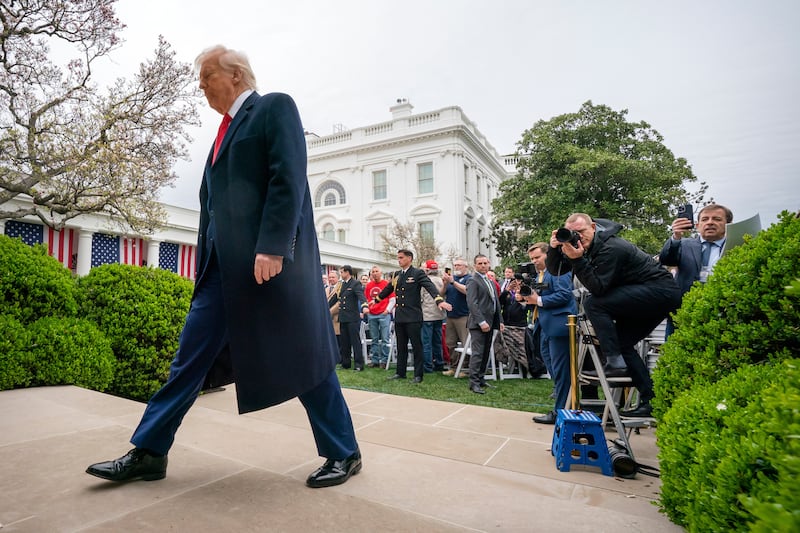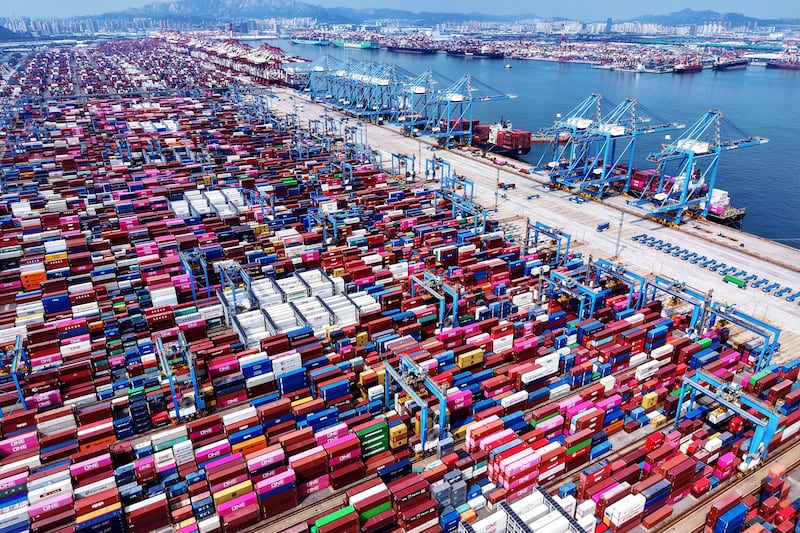- Distorted messages include the idea that tariffs are not taxes, are paid for by foreign countries rather than predominantly by U.S. businesses and households, and that trade deficits arise from being “taken advantage of” by other countries.
- In a world with roughly 200 countries, there is no reason to believe that bilateral transactions would be balanced. A household isn’t being ripped off by their dentist or the local supermarket because they run a persistent deficit with them.
- The trade deficit isn’t a measure of how much other countries are ripping us off; it is how much the U.S., as a whole, is borrowing from the rest of the world each year. And a big part of the reason why the U.S. runs a trade deficit is, far from a sign of weakness, because the U.S. has long been seen as an attractive place to invest.
- Ignoring services and fixating on merchandise makes the trade imbalance seem significantly bigger than it actually is. But what’s clear is that tariffs in general reduce both imports and exports, so the direction of their impact on the deficit is unpredictable.
- It may be politically attractive to blame China, India and Europe for the trade deficit, but this overlooks root causes, which are mostly domestic.
President Donald Trump campaigned on the promise of increasing tariffs applied to U.S. imports and, for better or worse, has sought to deliver on those promises. His efforts have been partially thwarted by negative market responses and legal challenges (a federal appeals court recently ruled that the majority of the tariffs imposed by the administration were illegal, confirming an earlier trade court ruling).
Nonetheless, U.S. tariffs are, for the time being, at a level dramatically higher than they have been for generations.
There have been numerous distortions made around the truth about tariffs, such as that tariffs are not taxes (they are), and that they are paid by foreign countries rather than predominantly by U.S. businesses and households (they are not).
The tariffs have also had a wide variety of stated justifications and objectives, some more plausible than others and some plainly contradictory. A common thread, however, is the view that the U.S. is being “taken advantage of” by other countries, as evidenced by a large merchandise trade deficit, and that this needs to stop.
On April 2 (“Liberation Day”), a set of “reciprocal” tariffs on almost every country in the world was announced. These tariffs, ranging from 10% to 50%, were untethered from known barriers faced in other countries by U.S. exporters. Rather, they were derived from bilateral (U.S.-by-country) merchandise trade deficits divided by U.S. merchandise imports from that country. The apparent thinking was that through such sweeping maneuvers, they could close the bilateral trade deficits and therefore eliminate the overall trade deficit.

Not looking at the full picture
To unpack this, it helps to go back to basic definitions. The U.S. balance of payments is a record of all economic transactions between U.S. citizens and the rest of the world. It is conceptually similar to a household’s annual budget, recording all incomings and outgoings.
In the current account, the value of flows associated with trade in goods and services, investment income earned abroad, and unilateral transfers (remittances and foreign aid) are recorded, while the capital account records international sales and purchases of assets, real estate, corporate stocks and bonds, government securities, and bank deposits.
The merchandise trade deficit is part of the current account, representing the difference between the value of U.S. exports of merchandise (goods) and its imports of goods in a given year. In 2024, the U.S. ran a merchandise trade deficit of roughly $329 billion.
This is not a new phenomenon — the U.S. has run a merchandise trade deficit every year since 1975. However, in 2024 the U.S. also ran a surplus in trade in services of roughly $78 billion, so the total trade deficit was really $251 billion.
As you can see, ignoring services and fixating on goods makes the trade imbalance seem significantly bigger than it actually is, overstating it by over 30%. Consider how much sense it would make for a household with two incomes to count only the dollars from one of those when evaluating its budget.

Addition isn’t causation
Because the overall trade deficit was assumed to be a consequence of bilateral trade deficits, these country-by-country deficits formed the basis for “reciprocal” tariff calculations. It is true that adding up bilateral surpluses/deficits across all trading partners must yield the overall balance, reflecting the basic commutative property of addition.
However, it is a mistake to infer causality. The fact that A plus B equals C does not imply that A and B cause C. Perhaps C causes A and B, or perhaps A, B and C are all driven by something else altogether.
While it might seem that bilateral imbalances have to be the result of unfair trade practices, they really reflect a variety of fundamentals. In the absence of trade, different countries would have different opportunity costs for the various goods that they would like to produce and consume, due to differences in productivity, the availability of resources or simply the preferences that drive demand.
Whatever the reason, the existence of differing opportunity costs creates the possibility of mutually beneficial exchange between firms and consumers in different countries. This is the fundamental driver of trade: Domestic firms gain higher profits by selling to consumers in other countries, and those consumers in turn pay lower prices than they would in the absence of trade.
There is no reason to think those transactions would balance across countries. Indeed, in a world with roughly 200 countries, the idea that bilateral trade flows would ever be balanced is as unlikely as it is unnecessary.
We don’t expect an employee to spend their wages only at their place of employment, and a household isn’t being ripped off by their dentist or the local supermarket because they run a persistent bilateral deficit with them.

Balances must balance
In any household, for every dollar of increased spending there must be an offsetting dollar of extra income or extra debt. It’s the same thing with American finances, where the overall balance of payments made must be zero. A current account deficit must be matched by a capital account surplus.
While it is tempting to think of the trade deficit as being simply caused by our trading partner’s policies, it’s far more complicated than that. It is impossible to eliminate the trade deficit without taking steps to eliminate net capital inflows (that is, increases in foreign investments in the U.S.), the costs of which would be significant. It would require some combination of higher taxes or higher saving, both of which reduce consumption, or less investment, which lowers growth.
A big part of the reason why the U.S. runs a current account deficit is, far from a sign of weakness, because the U.S. has long been seen as an attractive place to invest. That foreign investment has allowed U.S. citizens to benefit from growth.
Further, the U.S. fiscal deficit is largely financed by foreign purchases of U.S. Treasury securities, which are also a capital inflow. Any serious attempt to reduce the trade deficit would have to be accompanied by reductions in the fiscal deficit.
Tariffs are a blunt instrument
Tariffs can be useful in a limited set of very specific circumstances, but they come with significant costs. They do affect trade flows and therefore the trade balance, but are a minor factor, and using tariff policies in an attempt to address bilateral trade imbalances will do little.

Trade barriers high enough to eliminate trade entirely will obviously eliminate the overall trade deficit, at substantial economic cost. But that extreme aside, tariffs in general reduce both imports and exports, whether retaliation occurs or not, so even the direction of their impact on the deficit is unpredictable.
We wouldn’t expect a tax on the items a household consumes to necessarily improve a budget shortfall (although we would definitely expect it to hurt the household).
At the end of the day, the trade deficit isn’t a measure of how much other countries are ripping us off; it is how much the U.S., as a whole, is borrowing from the rest of the world each year.
Some of that borrowing finances productive investment. Much of it occurs because the U.S. runs a persistent fiscal deficit.
Blaming China, India and Europe for the trade deficit may be politically expedient, and simple policy solutions like tariffs are attractive on the surface. There is no doubt that getting other countries to reduce their trade barriers would be beneficial, for them and us.
But serious policy responses to the trade deficit must address its root causes, which are mostly domestic. Imposing crippling tariffs on our partners and ourselves isn’t a real solution, it is just creating another set of problems.


